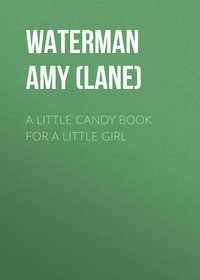 полная версия
полная версияA Little Preserving Book for a Little Girl
When the cooked juice and sugar reached the "jelly point" she skimmed quickly, poured into a pitcher, filled the sterilized small glasses at once, and stood in a sunny window. After the jelly was cold, Adelaide wiped around the top and outside of each glass with a damp cloth, poured melted paraffin over the top, shook it gently from side to side to exclude all air, pasted on the labels, then stored the jelly away in the preserve closet.
This finished the "jelly making."
CHAPTER IV
PRESERVING AND CANNING
"Mother," questioned Adelaide, "what is the difference between 'preserving' and 'canning'?"
"Well, dear, according to the cook books, preserved fruits are cooked with from three-fourths to an equal weight of sugar, while canned fruits have only sufficient added to sweeten. Some fruits are often canned without sugar, as it is not the sugar that keeps the fruit, but the perfect sterilization of fruit and jars. Sterilizing, you remember, is the killing of all germs by boiling."
"Some fruits I much prefer canning without sugar, such as apples, peaches, blueberries and rhubarb. When you open the jars in the winter time and add the sugar as you need it the flavor is almost like that of fresh fruit," answered mother.
"Oh, I see, so that is why our peaches taste so much better to me than anybody else's!" exclaimed Adelaide.
Adelaide began with strawberries, but first she read the "general rules" again that she had written down in the beginning, because she did not wish to make a single mistake.
Canned Strawberries

Emptying the berries into the colander she dipped it up and down several times in a pan of clear cold water, then let them drain thoroughly. The berries were hulled, weighed, and put into the saucepan, which she placed over the fire, heating the fruit through very gradually. It was better, mother said, to let them stand at the back of the range until the juice began to run, before bringing the berries to the boiling point. These boiled slowly five minutes, and then Adelaide added one-third their weight in sugar. The sugar had been standing in an earthenware dish at the back of the range, to heat through, but not brown.
While Adelaide added the sugar very gradually she stirred the fruit gently with the wooden spoon, and was very careful not to break the berries.
It did not take long for the fruit and sugar to come to the boiling point, and then Adelaide filled to overflowing the sterilized pint jar at once, inserted the silver knife between the jar and fruit to let the air bubbles rise and break, put on the new rubber smoothly, sealed quickly and stood the jar upside down out of the way of any draft.
The next morning she inspected the jar carefully, to be sure it did not leak, then wiped away all stickiness with a damp cloth, pasted on the label and stored it away in the preserve closet.
Canned Raspberries

Mother was delighted with this quart of raspberries, they were just ripe enough, large, and almost every one perfect. It did not take Adelaide long to pick these over, and she could see each center very easily. There wasn't a single bug or worm.
She weighed the raspberries before putting them in the colander to dip up and down several times in a pan of clear cold water. When they had drained, she emptied the berries into the saucepan and stood it on the back of the range to let the juice run. She also placed a third of their weight of sugar in an earthenware dish at the back of the range, to heat through, but not brown.
When the juice had run sufficiently, Adelaide moved the saucepan forward, the berries came slowly to the boiling point, and continued to boil very slowly for five minutes. It was then time to add the warm sugar, stirring very gently while it dissolved. Adelaide was very careful not to break the fruit. As soon as the fruit boiled again it was ready to pour into the sterilized pint jar.
Adelaide filled the jar to overflowing, inserted a silver knife between the jar and the berries to let all air bubbles come to the top and break, put on the new rubber smoothly, sealed quickly, then stood the jar upside down out of the way of any draft.
In the morning she made sure that the jar had not leaked, then with a damp cloth she wiped away all stickiness, pasted on the label and stored the jar away in the preserve closet.
Canned Raspberries and Currants

Adelaide picked over the raspberries and currants very carefully, washed and drained them in the usual manner, but kept them separate.
The currants she placed in the saucepan and mashed with the wooden potato masher. Next she cooked them very slowly until the currants looked white, then she strained them through two thicknesses of cheese cloth. Returning the juice to the saucepan, she added the sugar, stirring until it was all dissolved, and let it boil slowly twenty minutes, then she poured in the raspberries carefully and boiled them three minutes.
The sterilized pint jar Adelaide filled to overflowing at once, inserted the silver knife to force the air bubbles to the top, placed the new rubber on smoothly, sealed quickly and stood upside down out of the way of any draft.
In the morning she wiped off all stickiness with a damp cloth, made sure the jar did not leak, pasted on the label and stored it away in the preserve closet.
Canned Cherries

Mother liked to have her cherries cut in halves and the stones taken out, though she told Adelaide many people preferred them canned whole. Adelaide followed mother's way, so the large ripe cherries she placed in the colander, and washed thoroughly by dipping it up and down several times in a pan of clear cold water.
Next she removed the stems, and cut the cherries in halves with a silver knife, taking out the stones. Then she weighed the fruit. If they were tart, she used one-half their weight of sugar, but if they were of the sweet variety, she needed only one-third of their weight of sugar.
The cherries and sugar Adelaide put in the saucepan together and stood at the back of the range to heat gradually. As the sugar began to melt and the juice to run, she removed the saucepan forward and stirred the fruit gently with the wooden spoon. Adelaide was careful not to break the halves, and boiled the cherries slowly twenty minutes.
She filled the sterilized pint jar to overflowing, inserted the silver knife to bring the air bubbles to the top, placed the new rubber on smoothly, sealed quickly and stood the jar upside down out of the way of any draft.
In the morning she wiped off all stickiness with a damp cloth, inspected the jar carefully to see that it did not leak, pasted on the label and stored the jar away in the preserve closet.
Canned Blackberries

These were great big blackberries, firm but ripe, and Adelaide poured them into the colander. She could not resist popping the biggest one into her mouth, but mother told her that that was a very bad practice to begin. Adelaide sighed, but she realized mother was right, so she stopped eating any more and proceeded to wash the blackberries. She dipped the colander up and down several times in a pan of clear cold water, drained thoroughly, then weighed the fruit. Weighing one-third their weight of sugar, she put it in an earthenware dish and placed it at the back of the range to heat through, but not brown.
The saucepan containing the blackberries was also stood toward the back of the range until the juice began to run, when it was moved forward, and Adelaide watched it while it came slowly to the boiling point.
For five minutes the berries boiled very slowly, then the warm sugar was added a little at a time, and Adelaide stirred gently with the wooden spoon, being careful not to break the blackberries.
They were ready to put in the sterilized pint jar as soon as they boiled up again. Adelaide filled the jar to overflowing, inserted a silver knife to bring all bubbles to the top, placed on the new rubber smoothly, sealed quickly, and stood the jar upside down, out of the way of any draft. The next morning she examined the jar carefully to see that it did not leak, wiped off the stickiness with a damp cloth, pasted on the label, then stored the jar away in the preserve closet.
Canned Blueberries

The blueberries that mother bought were almost as large as currants and they were firm and dry.
Adelaide picked them over carefully, put them into the colander, which she placed in a pan of clear cold water, dipping it up and down several times to cleanse the berries thoroughly, then set aside to drain. The berries were then weighed, put into the saucepan and heated gradually.
To each pound of berries Adelaide added one-third of a pound of sugar, setting it in an earthenware dish at the back of the range to heat through, but not brown. When the berries had boiled slowly for five minutes, Adelaide added the sugar very gradually, stirring gently until it had all dissolved. The fruit was ready to can as soon as it boiled up again, and at once Adelaide filled to overflowing the sterilized pint jar. She inserted a silver knife between the fruit and the sides of the jar to bring all air bubbles to the top, then placed the new rubber on smoothly, sealed quickly and stood the jar upside down out of the way of any draft.
In the morning Adelaide removed all stickiness from the jar with a damp cloth, inspected it thoroughly to see that it did not leak, pasted on the label and stored the jar away in the preserve closet.
Canned Blueberries (without sugar)

Mother let Adelaide put up a jar of blueberries without sugar. They made delicious pies in the winter.
Adelaide picked over the berries carefully into the colander, then she dipped it up and down several times in a pan of clear cold water to cleanse them from all dust. After they had drained thoroughly, Adelaide poured them into the saucepan, with two tablespoons of cold water (this was to prevent burning), then she placed the saucepan over the fire and let the berries heat through very gradually. It was necessary to stir occasionally with the wooden spoon. They needed to boil but a minute or two, as they had softened sufficiently while heating through.
As soon as they were done, Adelaide filled the sterilized pint jar to overflowing, inserted a silver knife to let all air bubbles rise to the top, then break, placed the new rubber on smoothly, sealed quickly and stood it upside down out of the way of any draft.
After inspecting the jar next morning to be sure it did not leak, she wiped it carefully with a damp cloth to remove all stickiness, pasted on the label and stored the finished product away in the preserve closet.
Canned Peaches No. 1
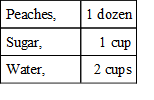
There were three different ways mother told Adelaide that she might put up peaches, two ways with sugar and one without. Adelaide put up a dozen peaches at a time.
The first dozen Adelaide placed in a pan and covered with boiling water and let them stand a few minutes. It was then easy for her to remove the skins with a silver knife, cut in halves and take out the stones. The peaches were large, and mother said they should fill two pint jars. So Adelaide washed and sterilized two jars. Into a saucepan Adelaide measured two cups of water and one cup of sugar, which she placed over the fire and let boil ten minutes, then she dropped the peaches in carefully and let them cook until you could pierce them with a silver fork. When they were done she lifted each half peach out with great care and put twelve of them in one pint jar, and the remaining twelve in the other pint jar. Next she filled the jars to overflowing with the syrup, inserted a silver knife between the fruit and the sides of the jars, to let the air bubbles rise to the top and break, placed new rubbers on smoothly, sealed quickly and stood both jars upside down out of the way of any draft.
The next morning she inspected them carefully to see that they did not leak; then Adelaide wiped off all stickiness with a damp cloth, pasted on the labels and stored the jars away in the preserve closet.
Canned Peaches No. 2
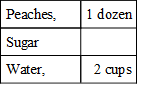
The second dozen of peaches Adelaide prepared in the same manner. She placed them in a pan, covered them with boiling water, let them stand a few minutes, removed their skins with a silver knife, cut them in halves, took out the stones, then weighed the peaches. Placing them carefully in the saucepan, Adelaide poured over the peaches one-third of their weight of sugar, and let them stand over night.
In the morning she added two cups of cold water and stood the saucepan over the fire, letting it come slowly to the boiling point.
From then on the peaches simmered slowly, until they could be pierced easily with a silver fork, Adelaide stirring occasionally in a careful manner with a wooden spoon so as not to break the fruit.
When they were sufficiently cooked, she picked out the fruit with the fork, putting twelve halves in each pint jar, filled them to overflowing with the syrup, then inserted a silver knife between the fruit and the jars to let all air bubbles rise to the top and break, placed the new rubbers on smoothly, sealed quickly, and stood the jars upside down out of the way of any draft.
In the morning she examined each jar carefully to be sure they did not leak, wiped off all stickiness with a damp cloth, pasted on the labels, then stored the peaches away in the preserve closet.
Canned Peaches (without sugar)

After Adelaide had covered the peaches with boiling water and let them stand a few minutes, she removed the skins with a silver knife, cut them in halves, took out the stones and placed them carefully in the saucepan.
To these she added two cups of cold water, put the saucepan over the fire, let the peaches heat through gradually, stirring occasionally with the wooden spoon, and then boiled them very gently for twenty minutes, or until they could be pierced easily with a silver fork.
Lifting the peaches out carefully with a fork, Adelaide put twelve halves in each sterilized pint jar, and filled them to overflowing with the juice.
Inserting a silver knife between the fruit and the sides of the jars, she let the air bubbles rise to the top and break. Next she placed the new rubbers on smoothly, sealed quickly and stood each jar upside down out of the way of any draft.
Next morning Adelaide examined each jar carefully to be sure they did not leak, wiped off all stickiness with a damp cloth, pasted on the labels and stored away the jars in the preserve closet.
Canned Apricots
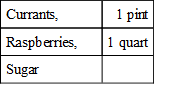
The apricots are so much smaller than peaches that one dozen, mother said, should just fill a pint jar, but, to be on the safe side, she would let Adelaide prepare eighteen. Mother also said she was surprised that more people did not can this fruit, it was of such a rich and delicate flavor.
Adelaide washed and wiped each apricot thoroughly, cut it in halves and removed the stone. After weighing the apricots she put them in the saucepan and added one-third their weight in sugar and one cup of water.
Placing the saucepan over the fire, Adelaide let the fruit come slowly to the boiling point, stirring frequently with a wooden spoon to prevent burning. After they had boiled gently twenty minutes (Adelaide stirred all the time being very careful not to break the apricots) she filled the sterilized pint jar at once.
Adelaide picked the apricots out with a silver fork and placed them in the jar first, then she poured in the juice so that it overflowed. Using a silver knife, she inserted it between the fruit and the jar, to let all air bubbles rise to the top and break. Next she placed a new rubber, which had been dipped in boiling water, on the jar smoothly, sealed quickly and stood the jar upside down out of the way of any draft.
In the morning the jar was carefully inspected to see that it did not leak, and Adelaide used a damp cloth to wipe away all stickiness. After pasting on the label she stored the jar away in the preserve closet.
Canned Pears
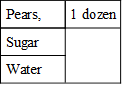
Adelaide prepared a dozen large pears, although mother said eight were quite sufficient (if large) to fill a pint jar. It was not a good plan to crowd such fruit as peaches, pears, and apricots in too closely, because you might break the fruit.
With the little sharp knife Adelaide peeled the pears very thinly and cut them in halves, removing the cores. The stems she left on. After weighing the fruit, she placed it in the saucepan and measured one cup of water to each pound of fruit. If the pears were tart, she weighed one-half their weight of sugar; if they were sweet she weighed only one-third their weight of sugar.
The sugar was put in an earthenware dish at the back of the range to heat through, but not brown.
Placing the saucepan containing the pears and water over the fire, Adelaide let them come slowly to the boiling point. With the wooden spoon she stirred them frequently, being careful not to break the fruit. If, after twenty minutes of gentle boiling, the pears were easily pierced with a silver fork, Adelaide added the warm sugar gradually and stirred carefully and constantly until it boiled up again.
Into the sterilized pint jar Adelaide lifted each half pear with a silver fork, then poured in the juice until it overflowed. The inserting of a silver knife between the fruit and the jar, to let all the bubbles rise to the top and break, was the next thing to be done, after which she placed a new rubber smoothly on the jar, sealed it quickly, then stood the jar upside down out of the way of any draft.
In the morning Adelaide wiped off all stickiness from the jar with a damp cloth, and examined it carefully to be sure that it did not leak. Next she pasted on the labels and stored the fruit away in the preserve closet.
Mother told Adelaide that some people found pears a little too flat for their taste, and in that case a tablespoon of lemon juice was added with each dozen pears.
Canned Crab Apples
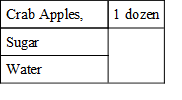
These crab apples made one of the prettiest jars Adelaide put up. She did not have to peel the crab apples, just wash and wipe the fruit thoroughly and remove the blossom ends. The crab apples, of course, needed to be absolutely perfect.
They were weighed, placed in the saucepan, and a cup of water poured over to each pound of fruit. One-half their weight of sugar Adelaide placed in an earthenware dish at the back of the range to warm through, but not brown. The saucepan she placed on the fire and let the crab apples and water come slowly to the boiling point, stirring frequently with the wooden spoon.
When the crab apples could be pierced easily with a silver fork Adelaide added the sugar gradually and let the fruit boil up again. She stirred constantly until they had boiled quietly five minutes more, then she picked the crab apples out with the silver fork and placed in the sterilized pint jar.
With a silver knife, which she inserted between fruit and jar, Adelaide let the air bubbles rise to the top and break. The new rubber, after being dipped in boiling water, was placed on the jar smoothly, then she sealed it quickly and stood it upside down out of the way of any draft.
In the morning the jar was carefully inspected for any possible leaks, and Adelaide wiped off all stickiness with a damp cloth. Next she pasted on the labels and stored the canned fruit away in the preserve closet.
Canned Quinces
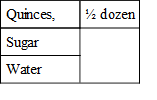
Six large orange quinces (these are of the best variety) Adelaide washed and wiped thoroughly, peeled, cut into quarters, and removed the cores. After weighing the quinces she measured into the saucepan one and one-third cups of water to each pound of fruit.
Placing the saucepan over the fire she let the water just boil, and then poured in the quinces. They boiled gently for about twenty minutes, or until you could pierce them easily with a silver fork. Adelaide lifted these out very carefully on to a large plate.
To the water in which the quinces had been cooked, she added one-half their weight in sugar. This she stirred with the wooden spoon until it was all dissolved and the syrup boiled. The quinces were gently dropped into the boiling syrup (Adelaide took particular care not to break the quarters) and when they had cooked slowly for five minutes she filled the sterilized pint jar with the fruit and poured the syrup over it until it overflowed. Next she inserted a silver knife between the fruit and the jar, to let all air bubbles rise to the top and break.
The new rubber, after being dipped in boiling water, was placed smoothly around the top, then she sealed the jar quickly and stood it upside down out of the way of any draft.
In the morning the jar was carefully examined to be sure that it did not leak, and Adelaide wiped off all stickiness from the outside. Pasting on the label she stored it away in the preserve closet.
Mother had told Adelaide to save the peelings and cores of the quinces, and put in a saucepan with just enough water to cover. These she let boil slowly for about one hour, then she poured them into the jelly bag to drain off the juice. This juice she used to cook her apples in when she canned some the next day.
Canned Apples
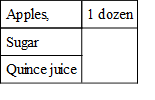
After washing and peeling the apples, Adelaide cut them into quarters and removed the cores.
The quince juice was made from the peelings and cores of the quinces she had canned the day before, by just covering them with cold water and boiling slowly for one hour. Then she drained them through the jelly bag.
To each pound of apples Adelaide measured one and one-third cups of quince juice into the saucepan, and she put one-fourth of their weight of sugar into an earthenware dish, which she stood at the back of the stove to warm but not brown.
The saucepan containing the apples and quince juice was placed over the fire, and the fruit came slowly to the boiling point. Adelaide stirred quite frequently with the wooden spoon, being careful not to break the fruit. When you could easily pierce the apples with a silver fork, they were ready to have the warm sugar added. This Adelaide poured in very carefully and stirred until dissolved.
Five more minutes they needed to boil, being stirred constantly, then Adelaide filled the sterilized pint jar at once. First the fruit (lifted out with a silver fork), then the syrup poured in to overflowing, then the silver knife inserted between fruit and jar, to let the air bubbles rise to the top and break, then the new rubber placed around the top smoothly, and lastly the quick sealing. Adelaide stood the jar upside down out of the way of any draft. In the morning she wiped off all stickiness with a damp cloth, from the outside of the jar, examined it carefully to be sure that it didn't leak, pasted on the label, then stored the jar away in the preserve closet beside her steadily growing line of preserves.




